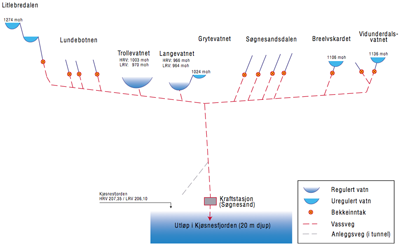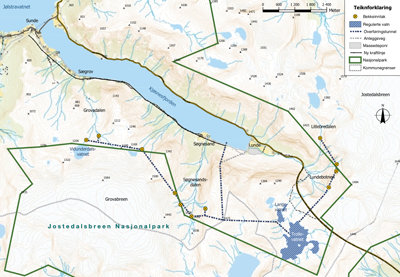Record drill+blast work in Norway
Jan 2009
Shani Wallis, Editor
- An advance of 175.8m in a single week in a 16m2 heading for a new hydropower project in Norway is claimed as a new drill+blast record.
- The achievement is credited to motivated, skilled and experienced crews and application of new, mucking equipment that is suited to the small tunnel cross section.
-

Record-breaking crew
- “A more normal advance for this size of a tunnel using drill+blast would be about 80-85m/week,” said Ole-Morten Okkenhaug, Project Site Manager for project contractorVeidekke Entreprenør AS. “As it is we are getting more than 100m/week as an average, and 104m/week is the average in the 16m2 heading over the last 10 weeks.”
- A TBM of about 3.5m diameter was considered for the tunnel excavation but as Okkenhaug explained, the headings for the total 21.5km of tunnelling on the new Kjøsnesfjorden hydroproject are too short and are of different diameters from16m2 to 37m3. “It takes a heading of at least 6km long for a TBM drive in Norway to be considered cost effective. The longest drive here is 7km and has two different diameters.”
- Additionally, all the headings have steep gradients of up to 1 in 6 to help achieve the 796m head difference between the powerhouse at 200m a.s.l. and the top of the highest intake at 1024m a.s.l. (Figs 1 and 2).
-
Equipment combinations
High in the mountains at the main reservoir (intake No 7) on the 16m2 x 4km long connection tunnel to convey water from intakes in Litlebredalen and Lundebotnen to the new Trollevatn reservoir, the equipment combination for the record breaking team comprised an Atlas Copco M2 two-boom jumbo, an ITC 312H3 loader, and three PAUS-ITC 10,000 low profile, articulated dump trucks. - The main advantage of the combination is in the mucking out cycles. The ITC loader has a capacity of 4-5m3/min for rapid loading of the 10-11m3 or 20 tonne PAUS trucks – the use of these units on a project in Norway. The record was set at the end of October, for the week from Monday 27 Oct to Sunday 2 Nov, when the heading was a little more than 1km from the portal. The 120-130m3 of muck created by each 4.5m pull/round was mucked out in 60-90 minutes. To start each round, the 50 x 4.5m long charge holes in the 16m2 hard granite faces are drilled by the AC M2 two boom jumbo, and charged, in 1.5-2 hours.
-

Equipment line-up
- “Normally we work two 10h shifts/day, 5.5 days/week, but on that week, all was going very well and we decided to try to beat the standing record in Norway for drill+blast tunnels of this size,” said Nils Age Tenold, a worker in the tunnelling teams at the remote camp site high in the mountains. “The previous record we believed was 165m/week set by a different company and crew on a hydro tunnel built in 2007. We beat that by another 11m at 175.8m in the two shifts/day from Monday to Friday and shift each on Saturday and Sunday.”
- Supporting the record-breaking effort was good quality rock requiring little if any support, and special facemask equipment that allowed the mucking crews to pass through the zone of blast fumes to reach the face more quickly and once the ventilation system had cleared the heading. Using these benefits to maximum advantage, the teams were able to achieve 39, 4.5m blasts in the record week of 175.8m advance.
-

ITC loader at work
- In the equipment combination, the ITC loader and the PAUS units have proven especially effective. The units are manufactured in Germany mainly for the mining industry. On this civil application, their narrow 1.95m width is suited to the small tunnel heading and the 180° reversible seat allows the driver to face the direction of travel at all times. ITC partners with PAUS to supply the complete mucking out package and rented the three 165kW, four-wheel-drive units to the Kjøsnesfjorden project.
- “We are very pleased with the PAUS units,” said Okkenhaug. “They are very robust and with the refurbished ITC loader, they are providing very close to 100% availability, which is a must for sustaining good production.”
-

A PAUS 10,000 in action
- Equally as importantly, the low profile ITC loader and the PAUS units are right for excavating smaller diameter headings. As Okkenhaug explained: “Most of the tunnels on the project need only to be about 10m2 for water intake purposes, but they need to be much bigger to accommodate the excavating equipment. With the ITC loader and the PAUS dump trucks we can reduce the cross section to 16m2, much smaller, and therefore much less expensive than the 22m2 section we need for work with the subcontracted fleet of five 18-21m3 (50 tonne) 4-axle dump trucks.”
- On these larger headings, crews are working with an Atlas Copco L2 2-boom jumbo and an ITC 312 SL Superloader into the bigger dump trucks.
- “TBM drives, had they been appropriate, would have been about 3.5m in diameter,” said Okkenhaug. “Our 16m2 headings with the ITC loader and PAUS units, are 3.8m wide x 4.5-4.8m high and with a 1m diameter ventilation duct in the crown.”
- In addition to the three units working in Norway, ITC has delivered PAUS dump truck units to several other projects around the world. This includes a fleet of 34 units to the Gautrain railway project in Johannesburg, South Africa with an ITC Superloader and a Terrex excavator. “We are happy to partner with PAUS for delivery of complete the mucking systems to drill+blast civil tunnel operations around the world,” said Carlo Bretz, Director for ITC. “The units are very strong and robust and we are working to introduce them with our ITC loaders also into China and South and Central America. At the Kjøsnesfjorden project in Norway, the big ITC Superloader has a 10m3/min capacity to load the 50 tonne (28m3) dump trucks in about two minutes but it was the smaller ITC 312H3 and the PAUS articulated units that achieved the record.”
-

Atlas Copco M2 jumbo
- In achieving the new record, it must be said also that the tunnel crews have an exemplary safety record to go with it. The record advance rates are also motivated by a bonus clause in the contract that offers the contractor a 50% stake in the electricity produced in the period ahead of the contracted start date in July 2010. With high generating output, strong demand for the electricity on the export market to other European countries, and a revised on-line target day of March 2010, the bonus for completing the 84MW installation by up to four months early is a keen motivating incentive. These incentives to achieve sustained high speed tunnelling often come at the cost of safety and commonsense attention. But at Kjøsnesfjorden, after 375,000 man hours to 1 January, 2009, there have been no casualties or injuries. “We have not had even a small injury,” said Okkenhaug. “Our sick rate is 2.1% of the man hours worked by crews of between 85 and 135 workers on the project at different times. This is very low by industry standards. We are very happy to have such a clean record in this regard as well.”
- Development of the new hydroelectric power plant started in April 2006 when the Kjøsnesfjorden Kraftverk generating company awarded the NOK 500 million (about $US71 million) civil works contract to Veidekke AS, one of Norways largest civil contracting companies. Supply and installation of the one Pelton turbine and other electrical and mechanical equipment is awarded as a NOK 130 million ($US18 million) contract to VaTech Hydro but Viedekke is responsible for bringing the negotiated turnkey project in on time.
- At a project investment of 800 million NOK (about €85 million or $US113.7 million), about €1 million ($US1.34 million) per megawatt, Veidekke’s turnkey contract includes excavation of about 500,000m3 of rock to create the 21.5km of water tunnels with 12 intakes, an underground powerhouse, and construction of two, asphalt core, earth-filled dams of a total 140,000m3, to create the Trollevatn reservoir with its 35.4 million m3 storage capacity.
-

Main dam construction
- The 21.5km of tunnelling is split into three main sections; the 4.5km long x 37m2 main headrace tunnel to a junction where the main drive splits to continue east for a further 2.3km to the Trollavann reservoir and west for 7km to Intake No 11. In addition there is the the 4km x 16m2 connection tunnel from the Litlebredalen and Lundebotnen intakes to the Trollevatn reservoir; several shorter tunnels to intermediate intakes; and a tailrace of about 1km from the power station to the fjord. All tunnelling on the project is by the drill+blast method with most of the intakes designed as river diversion weirs. There is one intake shaft of 5m2 x 155m deep, completed using an Alimak climber, and the high-pressure shaft from the headrace to the steel lined penstock is a 160m deep x 2.4m diameter raisebore.
- As work continues to progress well, Okkenhaug said that the remaining 2.2km of the 4.2km x 16m2 connecting tunnel will finish in August this year and the final 2.4km of the 7km long 22m2 west bound tunnel is expected to finish in September. By January 12, 2009, more than 16.2km of the 21.5km of tunnelling, or about 76.4%, was completed, the underground powerhouse was excavated, and installation of the one Pelton turbine was well under way. The machine hall cavern is supported with 3m and 4m long anchor bolts and finished with cast concrete. “The tunnels remain largely unlined with about 4,400m3 of permanent shotcrete applied as we progressed in the larger sized headings. We are definitely still on track at the moment to meet our early completion date of March 2010 to claim our bonus,” said Okkenhaug.
- Sustaining high average speeds of advance to complete the 84MW installation by up to four months early has proven a highly motivating incentive, all being achieved using very compatible equipment and without any compromise to safety.






